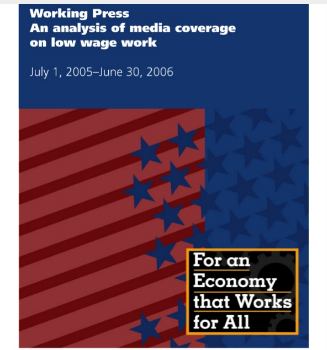When you have a burning issue you want to rally people around it is very tempting to “just get it out there.” But the risks are high that unless you have taken a cold hard look at the way your issue is being covered in the popular media you run the risk of being ineffective or at worst, counter-productive.
When we studied media coverage of low wage work we found that the stories focused on individuals, not systems even though it was the systems that needed to be fixed. The selection of the story frames that we pitched had to be re-calibrated to focus on different actors in the piece, such as employers and policy-makers. It was an important lesson.
The media is in many ways a reflection of the public conversation, social media especially. But often reporters and editors react to their own perceptions about what is important, who the authorities are, and how to best tell a story. So looking at how they cover an issue can help you present your issue to fit in or counter the narrative that media outlets are putting out.
- For example, seeing that stories of poverty are usually covered in terms of personal failures explains in part why systemic reforms to help the poor are rarely advanced.
- Documenting that religious leaders who appear on TV are virtually always far right conservative men can help a progressive religious leader build an argument for the inclusion of broader voices.
- Seeing that spokespeople on your side speak in jargon while your opponents use powerful, emotive statements suggests a remedy that can be addressed through training.
Analyzing media coverage entails taking a deep dive into the messages, stories, spokespeople, and framing of issues and quantifying that into data that can be tracked. It leads to strategic advice that can produce truly effective earned and social media campaigns that builds public will and counters resistance.
At DG+CO, we have conducted numerous media analyses covering a wide range of subjects – of importance to our public interest clients. We do this before, during and at the end of campaigns. These deep dives enable us to determine what the public is hearing, how stories are framed and where the dominant narratives are sourced. We have studied social, print and electronic coverage of:
- Public education
- Immigration and immigration reform
- Religion and politics
- Poverty and low wage work
- Higher education and community colleges
- Global and U.S. reproductive rights and health issues in the U.S, Nicaragua, Senegal, Uganda, and Burkina Faso
- Bio diversity
- Children’s rights in India, Kenya, and Brazil
- National security and privacy
- Voting rights
- Gun violence
- Learning disabilities
- Population growth
Because of our body of data, we are able to look toward the performance of other issues and organization’s to provide a comparison of effectiveness.
So before you send out that release, call a reporter or make an important public statement, an analysis of media coverage is in order.


